
The Carnegie Library of Pittsburgh is the public library system in Pittsburgh, Pennsylvania. Its main branch is located in the Oakland neighborhood of Pittsburgh, and it has 19 branch locations throughout the city. Like hundreds of other Carnegie libraries, the construction of the main library, which opened in 1895, and several neighborhood branches, was funded by industrialist Andrew Carnegie. The Pittsburgh area houses the first branches in the United States.
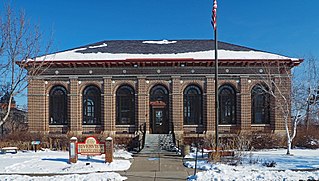
Riverview Branch Library is a branch of the Saint Paul Public Library serving the West Side neighborhood of Saint Paul, Minnesota, United States. It is a Carnegie library built in 1916. It was listed on the National Register of Historic Places in 1984 for having local significance in the themes of architecture and education. It was nominated for being one of only three Carnegie libraries built in Saint Paul, one of the first projects of Saint Paul city architect Charles A. Hausler, one of the last American libraries built with Carnegie Foundation funding, and for being an important neighborhood landmark in Beaux-Arts style. Many immigrants to Saint Paul lived on the West Side and the library was designed to serve those residents. Architecture critic Larry Millett noted a large amount of natural light and described it as one of the "West Side's finest buildings".

Lincoln Heights Branch Library is the second oldest branch library in the Los Angeles Public Library system. Located in the Lincoln Heights section of Los Angeles, California, it was built in the Classical Revival and Italian Renaissance Revival styles in 1916 with a grant from Andrew Carnegie. One of three surviving Carnegie libraries in Los Angeles, it has been designated as a Historic-Cultural Monument and listed on the National Register of Historic Places.
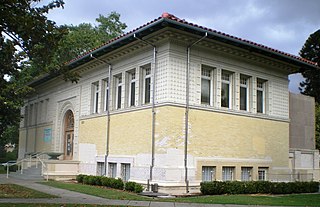
Vermont Square Branch Library is the oldest branch library in the Los Angeles Public Library system. Located about a mile southwest of the University of Southern California campus, in the Vermont Square district, it was built in 1913 with a grant from Andrew Carnegie. One of three surviving Carnegie libraries in Los Angeles, it has been designated a Historic-Cultural Monument and listed on the National Register of Historic Places.

The Ferndale Public Library was built in 1909 as a Carnegie Grant Library on donated land and supported by the city of Ferndale, California, until becoming part of the Humboldt County Library system in 1915. It is the only Carnegie Library in northwestern California still functioning as a Public Library.

The Burlington Carnegie Free Library is a Carnegie library located at 201 N. Third in Burlington, Kansas, United States. The library was built in 1912 through a $9,656 grant from the Carnegie Foundation; it housed the city's library program, which was established in 1884. Architect George P. Washburn designed the library in a Classical Revival style with three bays, a design he used in several other libraries. The one-story brick library sits atop a limestone foundation. The front entrance is topped by a pediment; the main door has a large decorative glass transon and is topped by a limestone lintel. The library was added to the National Register of Historic Places on June 25, 1987. The building is no longer a working library, as it was vacated after the opening of the Burlington branch of the Coffey County Library in 1994. It was later restored, and now serves as the home of Merry Investments LLC.
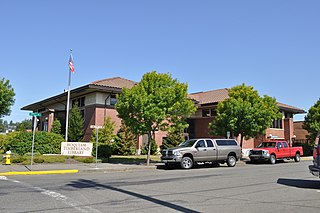
The Carnegie Library is a historic building still in use as the Hoquiam Timberland Library in Hoquiam, Washington.

The Calexico Carnegie Library is a Carnegie library located at 420 Heber Ave. in Calexico, Imperial County, California

The Exeter Public Library is a Carnegie library located at 309 S. E St. in Exeter, California. The library was built in 1916 with a $5000 grant from the Carnegie Foundation; it was one of six Carnegie libraries built in Tulare County. Exeter's library program had been started in 1910 by the city Women's Club but lacked its own building prior to the construction of the Carnegie Library. The library was designed in the Mission Revival style by A. Merrill Bowser, whose plans were selected from three designs submitted to James Bertram. The design includes a low hip roof, a gabled parapet, and a wide entrance with panels of glass to the sides of the door. A Union Jack motif is used in the windows and the transom above the front door. The building served as the city's library until 1976, when it became a community center. It is one of two surviving Carnegie libraries in Tulare County, the other being the Orosi Branch Library.
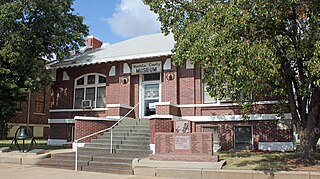
The Cordell Carnegie Public Library is a historic Carnegie library located at 105 E. First St. in New Cordell, Oklahoma. The library was built in 1911 through a $10,000 grant from the Carnegie foundation; New Cordell's Commercial Club, which had opened a reading room the previous year, solicited the grant. Architect A. A. Crowell designed the library in the Mission Revival style; several of its elements reflect the emerging Spanish Colonial Revival style. The building's curved parapet walls, exposed rafters, and original red tile roof are all characteristic Mission Revival elements; its segmental arches, sunburst moldings, and ornamental ironwork resemble Spanish Colonial Revival work. The library was the only one in Washita County until the 1960s; it also served as a community center and was regularly used by local schools. In 1982, a new library opened in New Cordell, and the Carnegie Library building became the Washita County Historical Museum.

The Colton Carnegie Library is a Carnegie library located at 380 North La Cadena Drive in Colton, California. The library was built in 1908 through a $10,000 grant from the Carnegie Foundation. Architect Franklin P. Burnham designed the Neoclassical building, the only example of the style in Colton. The building features an entrance portico supported by Ionic columns, a frieze and ornamented pediment above the entrance, and pilasters at the corners. In addition to housing the city's collection of over 1,000 books, the library hosted community meetings and social groups and even served as a church. The library moved to a larger building in 1982, and the building now houses the Colton Area Museum.

The Louis J. Bailey Branch Library is a historic Carnegie library building located at Gary, Indiana. It was built in 1918, and is a one-story, Colonial Revival style brick building on a raised basement. It has a slate gable roof and projecting entrance block with Corinthian order pilasters. The building was constructed with a $25,000 grant from the Carnegie Foundation. Beginning in 1919, it housed the Gary International Institute in the building's basement. The branch closed about 1963.

Union City Public Library is a historic Carnegie library building located at Union City, Randolph County, Indiana. A grant request application was sent to Andrew Carnegie in the Fall of 1903, announcement for the approval of the grant was received in Union City in early December 1903, construction bids were taken in early 1904, ground was broken and foundation construction was started in early June 1904, and the building was completed and the library's collection installed in May, 1905, in time for a public grand opening and celebration held on June 8, 1905. The structure, of which the final design was approved by Carnegie, is a Classical Revival style Indiana limestone building with an upper main floor, and a former basement storage area which has been converted over for a youth services library and programing. Its design features a wooden pediment supported by four Corinthian order limestone columns and a wood balustrade. Its construction was funded by a $10,000 grant from the Carnegie Foundation.
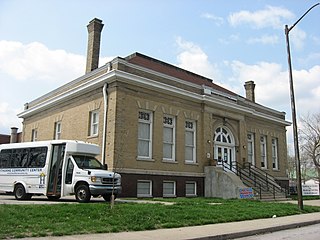
Hawthorne Branch Library No. 2, also known as Hawthorne Education Annex, is a historic Carnegie library building located in Indianapolis, Marion County, Indiana. Built in 1909–1911, with funds provided by the Carnegie Foundation, it is a one-story, rectangular, Classical Revival style brick and limestone building on a raised basement. It has a truncated hipped roof and features a slightly projecting pavilion housing a round arch. It was renovated in 1955, after its closure as a library, and again in 1999.

Indianapolis Public Library Branch No. 6, also known as Spades Park Library (Carnegie), is a historic Carnegie library located in Indianapolis, Indiana. It was built in 1911–1912, and is a two-story, L-shaped, Italian Renaissance style masonry building on a raised basement. It has a terra cotta tile hipped roof, decorative brickwork, limestone accents, and elements of American Craftsman and Arts and Crafts style decorative elements. It was one of five libraries constructed from the $120,000 the Carnegie Foundation gave the City of Indianapolis in 1909 to be used towards the construction of six branch libraries. The library remains in operation as the Spades Park Branch of the Indianapolis Public Library.

St. Joseph Public Library-Carnegie Branch is a historic Carnegie Library building located at St. Joseph, Missouri. It was designed by the architect Edmond Jacques Eckel (1845–1934) and built in 1902 in the Classical Revival style. It is a one-story, brick and limestone building over a raised basement. It features a projecting front portico with four fluted Ionic order limestone columns. It was built with a $50,000 grant from the Carnegie Foundation.

Sedalia Public Library is a historic Carnegie library building located at Sedalia, Pettis County, Missouri. It was designed by the architecture firm Shepley, Rutan and Coolidge and built in 1900. It is a two-story, cruciform plan, Greek Revival style wood and steel frame building with brick walls and limestone and terra cotta facing. It is seven bays wide with an open tetrastyle Ionic order portico on the front facade. It was the first public library in the state of Missouri to receive a Carnegie grant for construction of a library building. The grant was $50,000.

The Dickinson Branch Library, at 1545 Hooker St. in the West Colfax neighborhood of Denver, Colorado, is a Carnegie library which was built in 1914. It was listed on the National Register of Historic Places in 2002.

The Downs Carnegie Library in Downs, Kansas is a Carnegie library which was listed on the National Register of Historic Places in 1987.





















